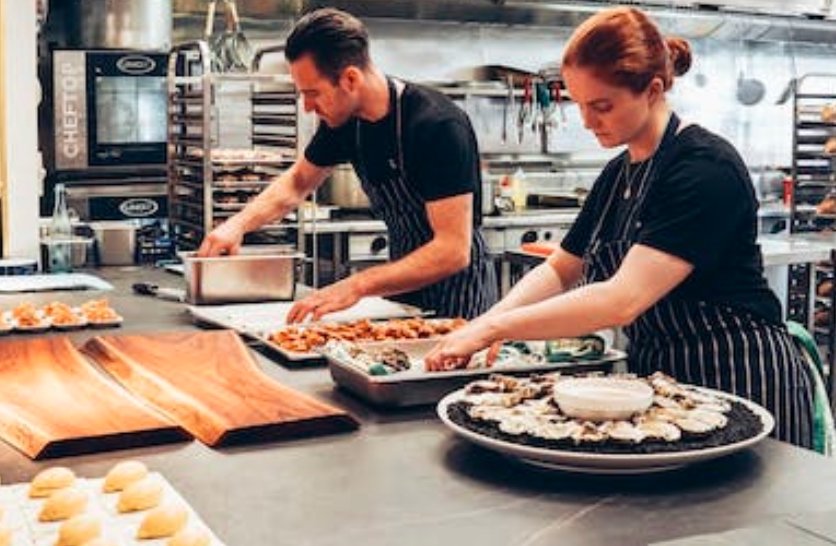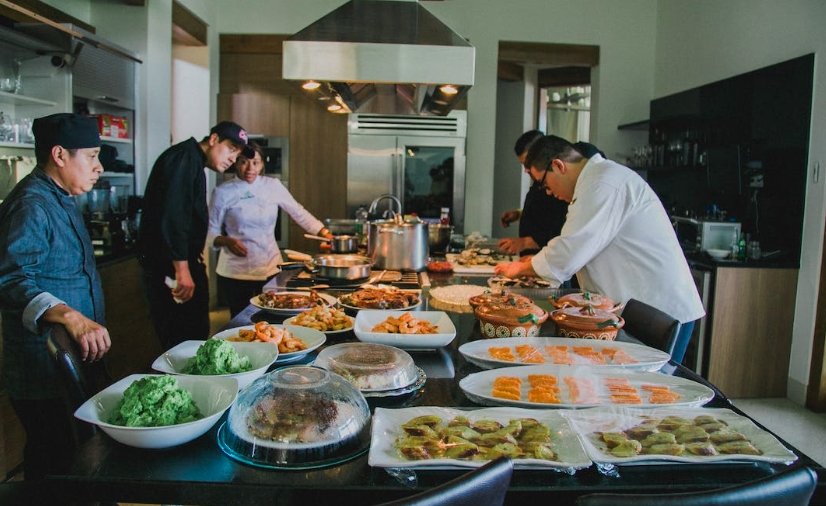Cooking is an art form, one that requires both creativity and technical skill. The ability to turn simple ingredients into delicious dishes is something that has been passed down through the ages, from home cooks to professional chefs. Mastering the art of cooking is not only a great way to impress your friends and family, but it can also be a source of immense satisfaction and pleasure. Knowing how to properly prepare a meal, from selecting the right ingredients to executing the perfect technique, is a skill that can have a profound impact on both your personal and professional life.
The importance of developing cooking skills cannot be overstated. Not only does mastering the art of cooking allow you to prepare meals that are unmatched in flavor and quality, it also gives you the opportunity to explore the culinary world. From exotic cuisines to classic comfort foods, the possibilities are endless. Furthermore, learning how to cook can help you save money as you won’t need to rely as heavily on takeout and convenience foods. Additionally, cooking healthy and nutritious meals is a great way to support a healthy lifestyle.
With the right techniques and tips, anyone can become a master in the kitchen. The Art of Cooking: Techniques and Tips for Mastering the Kitchen is the perfect resource for anyone looking to improve their cooking skills. From easy-to-follow recipes to in-depth advice on essential cooking techniques, this comprehensive guide provides everything you need to become a master chef in your own home. So, what are you waiting for? Grab your apron and get ready to discover the art of cooking!

Basic Cooking Techniques
Sautéing
Sautéing is a cooking technique that is used to quickly cook food in a small amount of fat over high heat. The main advantage of sautéing is that it seals in the food’s natural flavors and juices, while also creating a crispy texture. The most common type of sautéing is to use butter, but other fats can also be used, such as olive oil. When sautéing, the food should be cut into small pieces to ensure that it cooks quickly and evenly.
Grilling
Grilling is a method of cooking food over direct heat from either charcoal or gas. Grilling is an excellent way to cook food quickly and efficiently, and it also imparts a unique smoky flavor to the food. The most popular types of food to grill are meats, vegetables, and fruits. When grilling, it is important to keep the flame low and to not overcook the food.
Roasting
Roasting is a cooking technique that uses dry heat to cook food slowly in the oven. Roasting is a great way to cook tougher cuts of meat, as the slow cooking process helps to tenderize the meat. Roasting also helps to caramelize the food and to create a flavorful crust. When roasting, it is important to use a high-quality roasting pan and to keep the oven temperature low.
Baking
Baking is a cooking technique that uses dry heat to cook food by circulating hot air around the food. Baking is most often used to cook bread, cakes, and other pastries, as the dry heat helps to create a light and fluffy texture. Baking is also a great way to cook vegetables and fish, as the dry heat helps to keep the food moist and flavorful. When baking, it is important to use the correct baking temperature and to keep an eye on the food so that it does not overcook.
Cooking Tips and Tricks
1. Knives:
Using a sharp knife is essential when cooking like a pro. Dull knives are more likely to slip and cause injury. Always cut away from yourself and use the right knife for the right task. For example, use a chef’s knife to dice and slice, a serrated knife to cut bread, and a paring knife to peel and trim.
2. Seasoning:
Proper seasoning is key when cooking. Start with a little bit of salt and pepper and taste as you go. Experiment with a variety of herbs and spices to find the perfect flavor combinations. Use acidity to brighten up dishes and sweetness to balance out flavors.
3. Heat Control:
It is important to learn how to control the heat when cooking. Use high heat for searing and browning, low heat for simmering and poaching, and medium heat for sautéing and boiling. Always preheat the pan or pot before adding the ingredients.
4. Other Techniques:
There are other techniques that can help you cook like a pro. Invest in a good thermometer to make sure your dishes are cooked to the right temperature. Learn the techniques of blanching, braising, and roasting. Master the art of sautéing and grilling. Practice your knife skills and experiment with different flavor combinations.
Understanding Flavors and Seasonings
What are Flavors and Seasonings?
1. Flavors: Flavors are the combination of taste and smell that create the overall taste of a food. They can be used to enhance the flavor of a dish and make it more enjoyable. Flavor can come from a variety of sources, including herbs, spices, fruits, vegetables, and even some dairy products.
2. Seasonings: Seasonings are ingredients added to food to enhance its flavor. Common seasonings include salt, pepper, garlic, onion, ginger, and curry powders. These seasonings can be used to create a variety of flavor profiles, from mild to spicy.
How do Flavors and Seasonings work together?
1. Combining Flavors: When combining flavors, it is important to consider the overall flavor profile of the dish. For example, herbs and spices can be used to create an earthy flavor, while fruits and vegetables can be used to create a sweeter flavor. Knowing which flavors are complementary and which are not is essential for creating a delicious dish.
2. Enhancing Flavors: Seasonings can be used to enhance the flavor of a dish. Salt, for example, helps to bring out the natural sweetness of foods, while garlic and onions can add a savory note. Pepper can be used to bring out the flavor of other seasonings, and herbs can be used to add a bright, fragrant note.
How to Use Seasonings to Enhance Your Cooking
1. Balance: It is important to find the right balance when using seasonings. Too much of a certain seasoning can overpower the flavor of the dish, while too little can leave it tasting bland. Knowing the flavor profile of the dish is key to creating a balanced flavor.
2. Experiment: Experimenting with different seasonings and flavors is one of the best ways to become a better cook. Try using different combinations of herbs and spices to see which ones work best with the dish.
3. Taste: Always taste the dish before serving it. This will help you adjust the seasoning and ensure that the dish is flavorful and delicious.
Food Presentation
Presentation and plating in the culinary arts is an essential element that can make or break a dish. It is the ultimate way to make the food visually appealing and enhance its flavor. Presentation and plating are key elements in the art of cooking that can elevate the taste of a dish.
Main Body
1. Presentation: Presentation is the way food is arranged on the plate before it is served. It involves the proper selection and placement of ingredients on a plate in an aesthetically pleasing way. Presentation is an important aspect of the culinary arts and can be used to enhance the flavor of a dish.
2. Plating: Plating is the process of arranging food on a plate or platter. It is the art of arranging food in an attractive and appetizing way. Plating is essential for creating an appealing presentation and can be used to elevate the flavor of a dish.
3. Taste: Presentation and plating can be used to enhance the taste of a dish. Presentation helps to make food look more appealing, which increases the appetite of the diner. Plating helps to make food more balanced, which helps to bring out its flavor.
Mastering the Art of Cooking
Cooking is an essential skill for everyone, whether you’re an experienced chef or a novice home cook. With a few simple steps, it’s possible to become an expert in the kitchen and take your dishes to the next level. Here are some actionable steps you can take to master the art of cooking.
• Start with the Basics: Before you can create complex dishes, you need to learn the basics of cooking. Take time to learn the fundamentals, such as how to properly use a knife, how to tell when ingredients are cooked, and the different types of cooking methods.
• Follow Recipes Closely: Following recipes closely is the best way to learn how to cook. Be sure to read the instructions thoroughly before you start cooking, and measure all ingredients carefully to ensure that your dish turns out as expected.
• Experiment with Flavors: Once you’ve mastered the basics, it’s time to start experimenting with flavors. Try different herbs and spices, as well as different cooking techniques, to create unique flavor profiles.
• Practice Makes Perfect: Like any skill, practice makes perfect. Don’t be afraid to make mistakes – in fact, making mistakes is the best way to learn. As you practice, you’ll become more comfortable in the kitchen and your dishes will become more delicious.
• Take Notes: As you learn and experiment, it’s important to take notes. Record what worked, what didn’t, and what you would do differently next time. This will help you to remember the techniques and ingredients you used, and will make it easier to replicate your successes in the future.
• Learn from Others: No one is an expert in all areas of cooking. Tap into the knowledge of others by attending cooking classes, watching cooking shows, or reading cookbooks. This will help you to expand your skills and pick up new techniques.
By following these steps, you’ll be well on your way to mastering the art of cooking. With a little practice and patience, you’ll soon be creating delicious dishes that will impress your friends and family.

Common Cooking Mistakes and How to Avoid Them
Cooking is an enjoyable hobby for many, but it can be daunting for beginners. Even experienced cooks make mistakes in the kitchen, but these mistakes can easily be avoided. Here are some common mistakes that beginners make in the kitchen and tips for avoiding them.
• Not Reading the Recipe First: It is important to read the recipe through before starting to cook. This will allow you to ensure that you have all of the ingredients and equipment needed. It will also help you to understand the process and the cooking times involved, so you can anticipate any potential problems.
• Not Prepping Ingredients: It is important to prep your ingredients before you start cooking. This means measuring out the ingredients and chopping them into the required size. This will help you to ensure that your dish comes out correctly.
• Not Using the Right Equipment: It is important to use the right equipment when cooking. This means using the right size pots and pans, as well as the right type of knives and other utensils. Using the wrong equipment can lead to incorrect cooking times and poor results.
• Not Paying Attention to Cooking Times: It is important to pay attention to the cooking times indicated in the recipe. Not cooking the food long enough can result in an undercooked dish, while cooking it for too long can result in an overcooked dish.
• Not Testing the Food: It is important to test the food before serving it. This will ensure that the food is cooked correctly and that it tastes good.
• Not Cleaning Up: It is important to clean up as you go. This will help to keep the kitchen organized and make the cooking process smoother and more efficient.
By following these tips, you can avoid common mistakes in the kitchen and ensure that your dishes turn out perfectly every time.
Conclusion
The art of cooking is a lifelong skill that can be honed and perfected with practice, dedication, and patience. It is important to remember that cooking is not a race, but rather a journey. Every meal is an opportunity to learn, experiment, and refine new techniques and flavors. With the right tools, knowledge, and practice, anyone can master the art of cooking. From selecting the freshest ingredients to plating a delicious meal, the art of cooking is an enjoyable and rewarding experience. It is a skill that can be passed down from generation to generation and will continue to bring people together in the kitchen for years to come.
FAQs
1. What are the basics of cooking?
The basics of cooking include understanding the different cooking techniques, such as baking, boiling, sautéing, roasting, grilling, and steaming. It also involves understanding the different types of ingredients and their uses, seasoning and flavoring food, and following recipes.
2. What are the most important cooking techniques?
The most important cooking techniques include sautéing, grilling, roasting, and baking. Each technique yields different results and is used to create different types of dishes.
3. What is the best way to learn how to cook?
The best way to learn how to cook is to practice and experiment with different ingredients, techniques, and recipes. Practice makes perfect, so don’t be afraid to try new things and make mistakes along the way.
4. What are the benefits of cooking at home?
Cooking at home allows you to control the quality of ingredients, the types of dishes you make, and the amount of time and effort you put into it. Additionally, cooking at home allows you to save money, be more mindful of your health, and enjoy the process of creating a delicious meal.
5. How do I know which ingredients to use when cooking?
When selecting ingredients, it is important to consider the flavors, textures, and nutrients of each ingredient. You should also consider how the ingredients will interact with each other to create a delicious and balanced dish.
6. What are some tips for cooking with fresh ingredients?
When cooking with fresh ingredients, it is important to rinse them thoroughly and store them properly. Additionally, use the freshest ingredients possible, as they will yield the best results.
7. How can I become a better cook?
To become a better cook, practice different cooking techniques, experiment with new ingredients, and use recipes as guidelines rather than hard and fast rules. Additionally, be open to feedback and constructive criticism to help you improve your cooking skills.
8. What are the most essential kitchen tools?
The most essential kitchen tools include a chef’s knife, cutting board, sauté pan, baking sheet, tongs, spatula, whisk, measuring cups and spoons, and a thermometer.
9. What are some tips for mastering the art of cooking?
To master the art of cooking, practice different techniques and recipes, experiment with unique ingredients, use fresh ingredients whenever possible, and pay attention to the details. Additionally, be willing to make mistakes and learn from them.
10. What are some tips for seasoning food?
When seasoning food, it is important to taste as you go to ensure that the flavors are balanced. Additionally, it is important to consider the type of dish you are making, as well as the individual ingredients and their flavors.


















